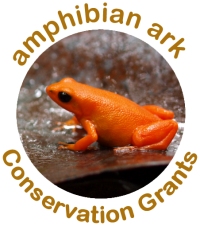 AArk has offered grants since 2009 and in the past these have been predominantly seed grants, for newly created ex situ programs, for species that have been assessed as in need of urgent ex situ rescue.
AArk has offered grants since 2009 and in the past these have been predominantly seed grants, for newly created ex situ programs, for species that have been assessed as in need of urgent ex situ rescue.
In 2018 our grants program was expanded, to include a wider range of programs types that are eligible for funding, as well as some new guidelines and requirements for grant recipients. Download the complete guidelines here.
Our grants are intended to support conservation projects for amphibian species that cannot currently be saved in the wild, with a focus on ex situ actions, and in partnership with appropriate field activities. Preference will be given to projects for species which have been assessed as in need of ex situ rescue or research work, either as a recommendation from a Conservation Needs Assessment (www.conservationneeds.org) or a similar, national assessment process.
Guidelines and requirements
All applications must reflect AArk values. Please pay careful attention to the grant guidelines, and address all of the appropriate items.
Format Guidelines
- Ideally, proposals should be submitted in English or Spanish, but it can be submitted in any language.
- The body of the proposal (including content points 1-6 above) must not exceed three pages, excluding budget (≤1 page) and literature cited (≤½ page). Proposals longer than five pages in body length will not be reviewed.
- All materials should be submitted together, as .doc or .pdf files attached to a single e-mail. File titles should include the name of the grant’s principal researcher. The two supporting letters should be sent as separate files.
- Only e-mailed proposals will be accepted. Submit proposals to: grants@amphibianark.org. All correspondence should have “AArk Conservation Grant Proposal/principal researcher’s name” in the subject line.
Application submissions
Ideally, grants should be submitted at least one week before the deadline, so they can be reviewed, and returned for alterations if needed. Grants submitted on the due date cannot be modified and will be accepted as is. Applications and inquiries should be directed to grants@amphibianark.org.
Need some help?
AArk staff are available if you need assistance in formulating your proposal. Please do not hesitate to contact us with any questions. Each year several proposals have been rejected due to issues that could have been prevented with a little extra guidance! We also have several past seed grant recipients who are willing to act as mentors, to help with your application – please let us know if you would like us to put you in contact with one of them. Email us at grants@amphibianark.org.
Important dates
- Program Outline deadline: 8 September 2023
- Applicants notified about review of Project Outlines: 22 September 2023
- Grant application deadline: 6 October 2023
- Grant decision/notification date: 31 October 2023
- Successful applicants must provide bank account details, signed MOU and 3-4 photos of species and/or facilities by: November 2023
- Initial progress report and species action plan provided by 1 June 2024
- Final progress report, species action plan and husbandry guidelines due 15 January 2025







